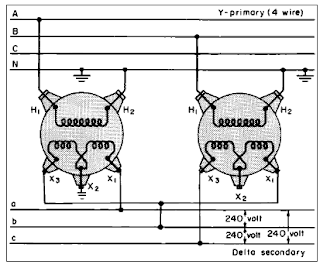The theoretically ideal conditions for paralleling transformers are:
1. Identical turn ratios and voltage ratings.
2. Equal percent impedances.
3. Equal ratios of resistance to reactance.
4. Same polarity.
5. Same phase angle shift.
6. Same phase rotation.
Single-Phase Transformers
For single-phase transformers, only the first four conditions apply, as there is no phase rotation or phase angle shift due to voltage transformation.
If the turns ratio are not same a circulating current will flow even at no load. If the percent impedance or the ratios of resistance to reactance are different there will be no circulating current at no load, but the division of load between the transformers when applied will no longer be proportional to their KVA ratings.
Three-Phase Transformers
The same conditions hold true for three phase transformers except that in this case the question of phase rotation and phase angle shift must be considered.
Phase Angle Shift
Certain transformer connections as the wye-delta or wye-zigzag produce a 30º shift between the line voltages on the primary side and those on the secondary side. Transformers with these connections cannot be paralleled with other transformers not having this shift such as wye-wye, delta-delta, zigzag-delta, or zigzag-zigzag.
Phase Rotation
Phase rotation refers to the order in which the terminal voltages reach their maximum values. In paralleling, those terminals whose voltage maximums occur simultaneously are paired.
Power Transformer Practice
The preceding discussion covered the theoretically ideal requirements for paralleling. In actual practice, good paralleling can be accomplished although the actual transformer conditions deviate by small percentages from the theoretical ones.
Good paralleling is considered attainable when the percentage impedances of two winding transformers are within 7.5% of each other. For multi-winding and auto-transformers, the generally accepted limit is 10%.
Furthermore, in power transformers of normal design the ratio of resistance to reactance is generally sufficiently small to make the requirement of equal ratios of negligible importance in paralleling.
When it is desired to parallel transformers having widely different impedances, reactors or auto-transformers having the proper ratio should be used. If a reactor is used it is placed in series with the transformer whose impedance is lower. It should have a value sufficient to bring the total effective percent impedance of the transformer plus the reactor up to the value of the percent impedance of the second transformer.
When an auto-transformer is used, the relative currents supplied by each transformer are determined by the ratio of the two sections of the auto-transformer. The auto-transformer adds a voltage to the voltage drop in the transformer with the lower impedances and subtracts a voltage from the voltage drop in the transformer with the higher impedance.
Auto-transformers for use in paralleling power transformers are specially designed for each installation. The wiring diagram showing the method of connecting the auto-transformer is usually furnished.
In general, transformers built to the same manufacturing specifications as indicated by the nameplate may be operated in parallel.
Connecting transformers in parallel when the low voltage tension is comparatively low requires care that the corresponding connecting bars or conductors have approximately the same impedance. If they do not, the currents will not divide properly.







